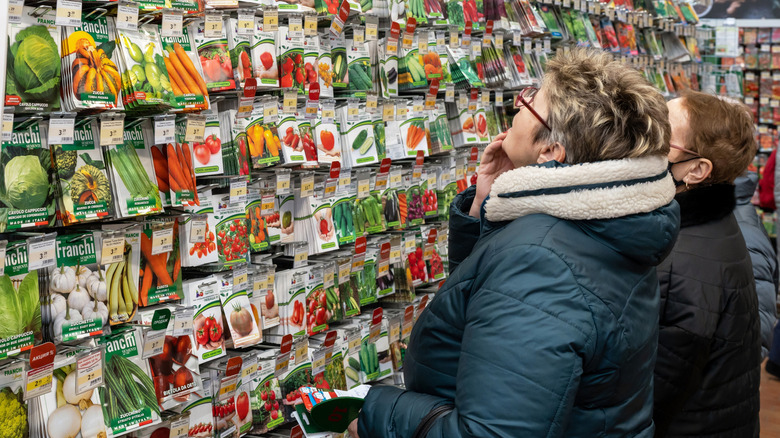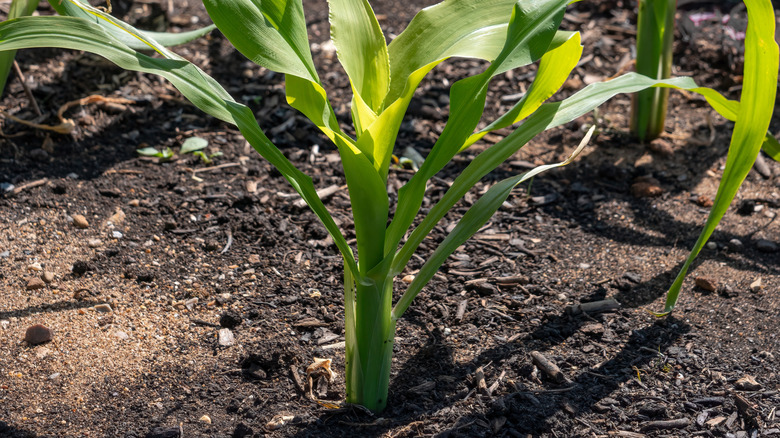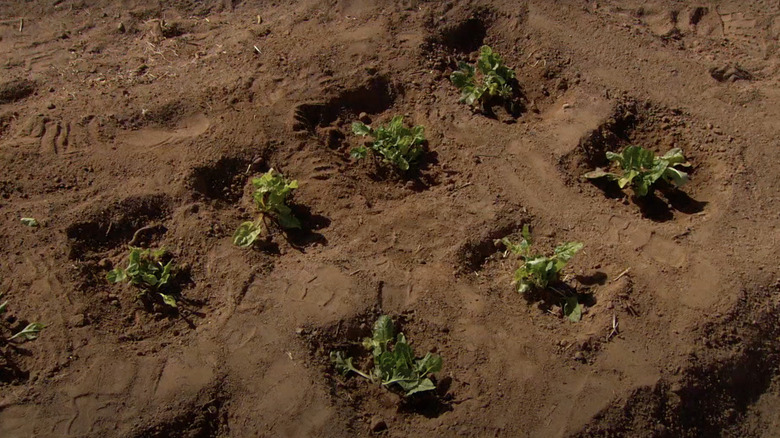The Best Vegetables To Grow In A Waffle Garden
What is a waffle garden and how does it make growing in the desert easier? In the simplest terms, a waffle garden is crafted from a series of berms and depressions, with each depression forming a sort of small garden bed. This unique construction retains more water than traditional gardens, helping people grow crops in dry climates. So, now that you know what a waffle garden is or perhaps have even already planned one out for your backyard, you're probably wondering which vegetable seeds or seedlings you should pick up. Essentially, anything that holds up well in high heat will work. Think vegetables like green onions, garlic, chilis, beans, squash, corn, beets, and tomatoes; leafy greens like amaranth, lettuce, chard, and mustard greens; herbs like cilantro and basil; and ornamental edible plants like sunflowers.
In North America, waffle gardens were pioneered and used extensively by the A:shiwi people of Zuni Pueblo, New Mexico, for thousands of years. They built these distinctive horticultural innovations on the banks of the Zuni River, where one 25 by 40 foot garden (the typical size) provided food year-round for a single extended family. Hence, this style of garden is sometimes also called a Zuni waffle garden. While the A:shiwi people are the most well-known waffle gardeners, archeological excavations in Egypt have uncovered similar dry-farming constructions dating to the second millennium BCE. As modernity encroached on the A:shiwi, waffle gardens shrunk. However, there has been a resurgence of interest in the technique since the 1990s, as home gardeners and horticulturists alike seek better ways to farm affordably and conservatively in arid environments.
A waffle garden vegetable shopping list
The Three Sisters, an indigenous American companion planting system in which nitrogen-fixing bean vines grow up the stalks of corn, and squash, pumpkin, or melons provide a living mulch below, works well in waffle gardens. Species to consider include Hopi blue corn, Cherokee Long Ear Popcorn, and Painted Mountain corn; pole beans like scarlet runner beans, snap beans, or Tarahumara beans; and early white bush scallop squash, yellow or crookneck squash, buttercup squash, and winter squashes. In a dry-climate waffle garden, aim to plant the corn, beans, and squash 4 inches deep in clay soil and 8 inches deep in sandy soil. Each depression will house up to eight corn and bean seeds and a maximum of two squash seeds.
Other vegetables are traditionally (or not so traditionally) grown in waffle gardens, too. Among the alliums, onions (especially I'itoi onions and scallions), and garlic do well with little care. Try virtually any sun-loving variety of chili. (Jalapeños are a popular choice.) Beets and heat-tolerant tomatoes like Punta Banda, Pomodoro Pizzutello di Paceco, and 'Black Vernissage' are among the less traditional but now popular waffle garden additions. For leafy greens, try planting lettuce, chard, mustard greens, or the more obscure amaranth (which is also a grain). The best herbs include cilantro and Mediterranean basil. Sunflowers are a popular and authentic addition to any waffle garden; Plant these vibrant blooms in the borders of each depression. Try the native Max or Maximilian sunflower (Helianthus maximiliani), which boasts flower heads on the smaller side.
Making the most of your waffle garden
While people often plant squash, melons, and corn in their waffle gardens, it's possible these particular species may grow better in more typical field gardens. Corn, for example, can topple when you flood the depression with water. Vining plants like squash need space to spread out or up. You're also safer choosing heirloom and heritage vegetable varieties with proven success in waffle gardens or buying from specialist seed banks like Native Seeds SEARCH. In short, if you're a first time waffle gardener, factor in a period of experimentation to see which vegetables grow best.
Waffle gardening is a type of climate-conscious gardening. Knowing what it is and how to implement it will give your plants the best chance of thriving. Each indented waffle section should be 12 by 12 to 36 by 36 feet square. Build up the rim by adding water to the dirt you dig out. What you can grow will depend on the natural fertility of your specific soil. It wouldn't hurt to test your soil to identify its composition and deficiencies before you start your garden. Traditionally, Zuni gardens were amended with floodplain sand, forest soil, and manure. Home gardeners can add a good quality compost in the fall for spring planting. After planting your seeds or seedlings, wait until they've put down sturdy roots before flooding each depression with water. Take a leaf from the A:shiwi and succession plant to maximise your harvests in any given season.


